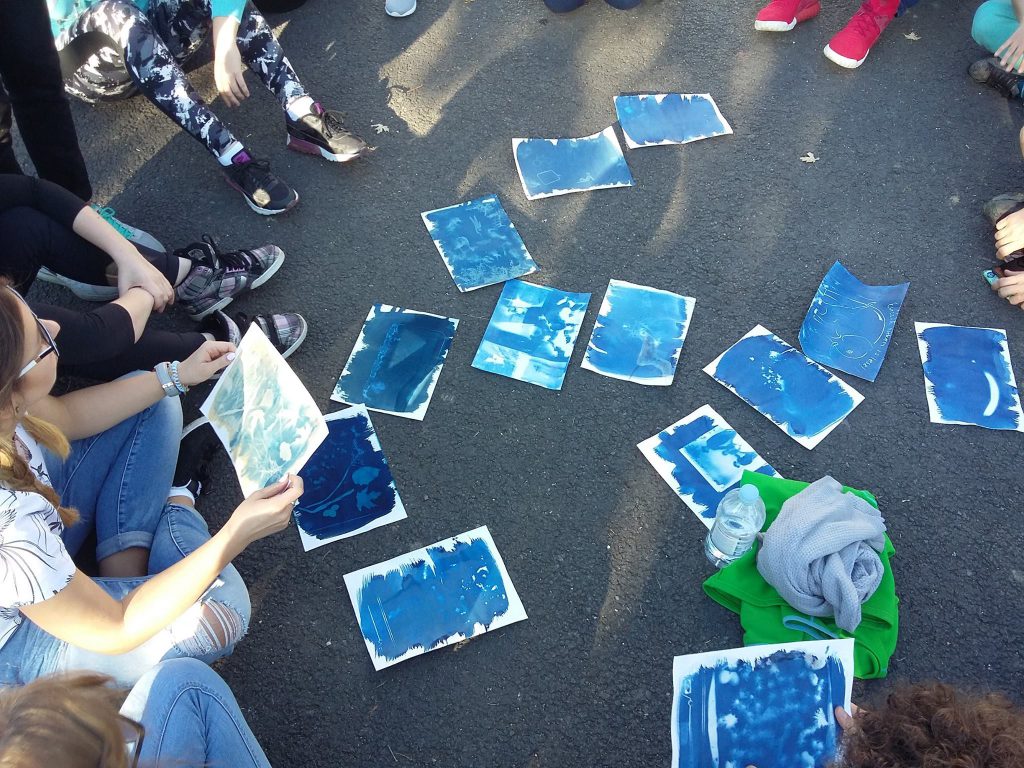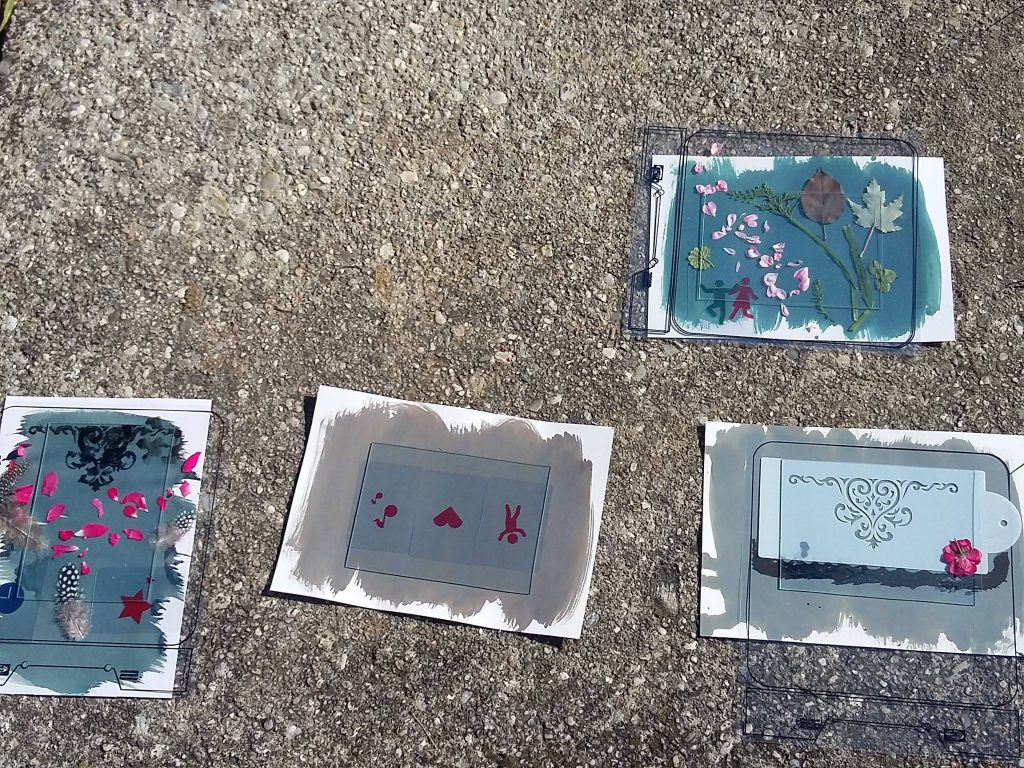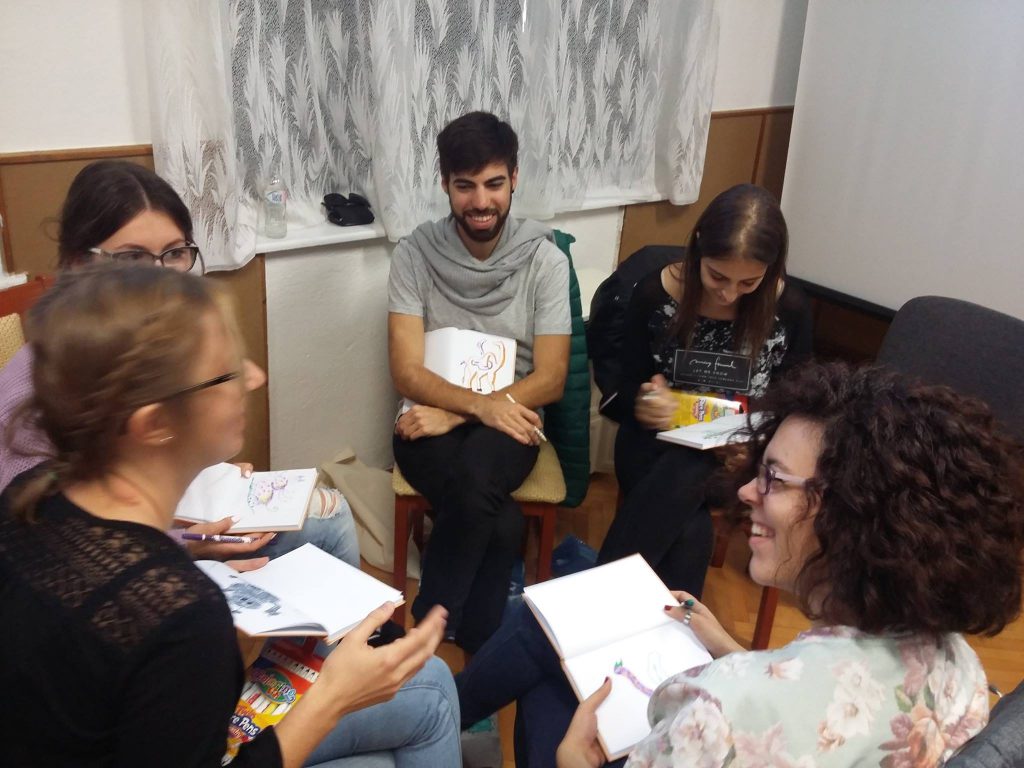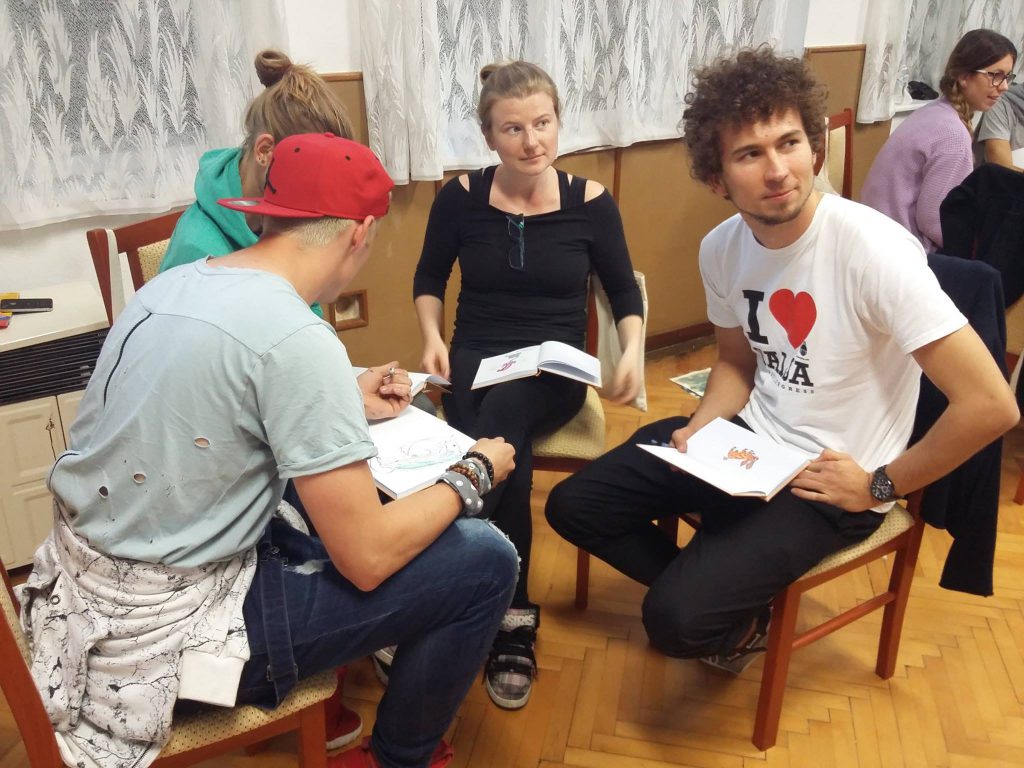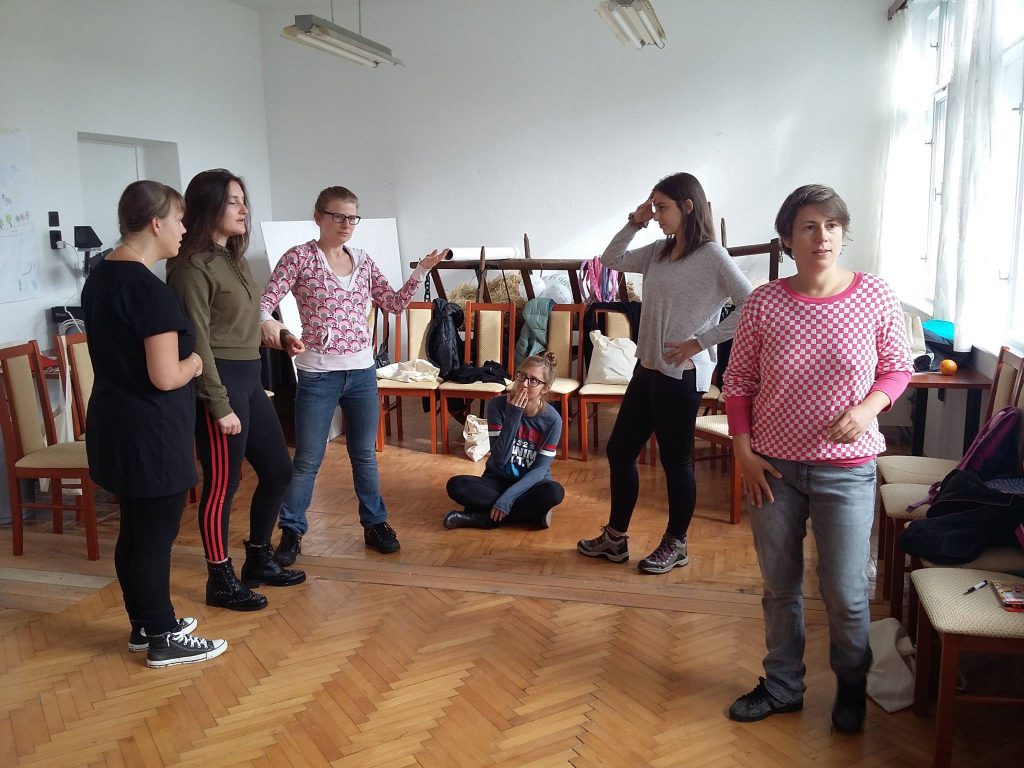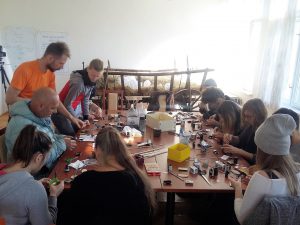Introduction
SSCA (Seven Step Configuration Analysis) is a psychodiagnostical tool. At this level SSCA requires a lots of practice and a solid psychological knowledge or background. Although the specific methods, techniques used in SSCA, and the holistic and systematic point of view gives us the possibility to work with values outside of therapeutic setting: mainly as a spectator/examiner or as a creator.
For this purpose in this document we highlighted those techniques (specifically at the step of Intuitive analysis), which are the most useful and can be easily adapted, while the ones that require much deeper prior knowledge are summarized for understanding.
Using these tools as a spectator we have the chance to gain deeper understanding through a visual medium which is essential nowadays: visual information is influencing our life in a way that never happened before. It can help to raise the spectator’s sensitivity towards others and stay in contact with its target group and their reality, while creating the opportunity to discover their values.
A creator can use these methods to build up dialogs consciously through a visual medium – possibly sharing its values. In our work the most important way to use it to create a deeply grounded and specific activities to reflect back someone’s own values, which looks hidden for the first sight.
What is SSCA?
The Seven−Step Configuration Analysis (SSCA) is a method of psychological interpretation of pictorial expression (e.g. projective drawings and paintings) in a systems analysis approach. The SSCA is a scheme of psychological interpretation derived from studies of expert thinking. It was developed in the building of the ESPD (Expert System for Projective Drawings) as a cognitive model. The model consists of seven phases, each of which builds upon the previous one, which represent the successive individual steps of the psychological understanding of pictures or other projective tests. The SSCA has two basic theorems derived from the ESPD model: the first theorem of SSCA is that pictures are analyzed only in context, i.e. they are related to case history, test behavior, current conditions, the subjects’ own interpretation, as well as other items in the present and previous pictures by the same subject; the second theorem is that only configurations are interpreted. The final result of the SSCA is the ‘essence’ of the picture, i.e. a concise but extendable summary of a picture’s psychological significance.
The seven phases can be summarized as shown in a systems analysis approach. It consists of the:
- Context analysis
- Process analysis
- Phenomenological analysis
- Intuitive analysis
- Global analysis
- Item analysis
- Finding the essence
SSCA method in action
Materials needed
- Min 5 A4 paper for each participant (plus A4 heavier paper for the shadow theater: participants have to cut out their drawings, and create a puppet out of them)
- Medium graphite pencil for scribble test and mothoric empathy
- Extra slides (transparent thin plastic sheets) for the overhead projector
- Black permanent markers for the slides
- Drawing board or something to draw on
- Color crayons or color pencils (10-12 color set) / participant
- Skewers (narrow wooden or bamboo stick) or thin straws
- Scotch tape
- Scissors
- Light source (projector or some directed light for the shadow theater)
- Canvas (for the shadow theater)
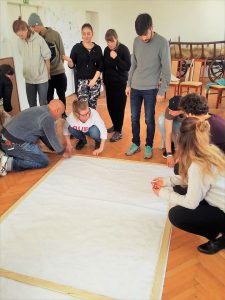
Preparation of the setting
Prepare the „stage” considering that canvas has to be big enough for the presentation (1,5m x 2m was enough for 5 people to work in one team). Recommended light source is an overhead projector (brightness is optimal, and presenters may use the slides or any other space between the projector and the canvas). Dimming out the room for the shadow theater is essential.
Goal
To introduce the concept of SSCA, learn specific tools from the Intuitive Analysis step, focusing on Motor empathy, Kinesthetic empathy.
In this session we will experience an activity developed on the background of SSCA and other expressive art therapeutic tools. (In other words: we reverse engineered an art therapeutic tool and created an activity out of it) The Non-existent animal activity can be directly implemented in youth work at the stage of group formation or in a later stage to adress different topics like: communication, personal needs, personal strength, persoanl weakness, connection, self awareness, family, personal connections, values, hiddent talent, hidden skills.
Short intro
Scribbling
leaded personal work
Materials needed: 16 sheets of size A6 plain, white paper (fold a sheet of A4 in half, and then fold that in half again) and a soft pencil.
Instructions for the modified Grätz Scribble Test
Please use these exact words when you gave the instructions: ”I will say a few words. Please, depict the impression or inner motion you experience in response to the words, using spontaneous lines or shapes that do not depict the objects. You can use one folded cell for each word. When you have done this, faintly write the word on the reverse side of the paper, so that it does not show through”
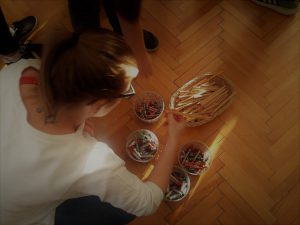
Slowly following the participants rhythm one-by-one say these words
| 1. anger 2. fear 3. hate 4. forgiveness 5. attraction 6. jealousy 7. desire 8. despair |
9. resistance 10. safety 11. aggression – attack 12. loneliness 13. value* 14. dance 15. father 16. mother |
*This is a modified version of the original test: you can ask in the 13th position a conflict word what should be related to a patient’s inner conflicts originally. Since this is not a therapeutic session we recommend to choose a word yourself in this position (as a 13th word to scribble, in this example “value”) or let the participants choose freely one as the last word. (16th position)
HINT: In this method, participant depicts a total of 16 stimulus words on four A4 sheets of paper non-figuratively, with scribbles. The sheets are folded in four, resulting in four rectangles on each sheet; the subject uses those to draw. How to avoid main pitfalls? If the participant does not understand the task or how to scribble show them a few examples of what a non-figurative scribble means. For example draw the following: „cotton-wool” (circular light doodle) or „glass” (sharp, pointed lines).If the participant draws a symbol or pictogram (heart, sun etc.) instead of a nonfigurative scribble, ask them to redraw it but only without making a figurative scribble. Starting with anger is a good introduction to this scribble method, since it brings out easily very dynamic motor impulses, which gives an initial feeling of success.
Analysis of the Gratz scribble test
guided personal work
1: Latent Meaning Of Movement Similarity
First of all, place all the scribbles face-up in front of your participant on a table or on the floor randomly (makes sure there is enough room for this). We ask the client to group the scribbles according to similarity of movements patterns. For instance put circular scribbles in one group, the straight and sharp lines in another group, the geometrical forms in a separate group, etc. Do not look at what is on the other side of the paper! Look only looking for phenomenological similarity (e.g. line pressure, movement patterns, shapes). When this is ready you get to the main point. Turn the pieces of paper over and see which words were placed next to each other. Why are we looking for similarity? What does it mean if we find it? Things that we depict in a similar manner, we think of in a similar way. Therefore, their representation contains mutual components. Important: never offer your own explanation for the similarity. Ask the participants in a non-directive way: „Why do you think these scribbles resemble each other?” If you have carried out the method correctly, this will result in the subject’s positive recognition of components of the unconscious coming to the surface (e. g. father, anger, aggression, jealousy and hate scribbles may be grouped together).
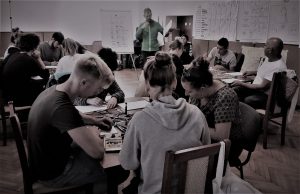
2: Anatomy of Lines Using Motor Empathy
Now we are looking for an answer to what the scribble says about the individual experience of the expression. The Grätz Scribbles reveal, what it is the subject has a problem with, how serious the conflict is and how they combat this.
For instance, with what intensity, with what pressure, to what degree of spatially extension a scribble was made? How much was it controlled? As the energy component of a scribble increases, so does the psychological energy become concentrated. As the lines become more and more controlled (for instance they are small, made with moderated, withheld movements) then the subject is increasingly controlling (or suppressing) an emotion.
Intuitive Analysis and Motor empathy
presentation and guided personal work
Scribbles maybe the simplest way to get an insight to the unconscious. Scribbles are everywhere: on the side of a notebook, on benches, on playground paving stones, on walls and in public bathrooms. The psychological interpretation of scribbles (doodles) is an excellent field for the study of everyday psychopathology. You can use different methods but now we experience the Motor Empathy Method of the SSCA for understanding scribbles.
- Take a spontaneous scribble and place it in front of you. Try to imagine what movements were used to make it, for instance where it started, where it finished.
- Take a similar sized clean sheet of paper and pen/pencil.
- Try to copy, to reproduce the scribble, exactly as the client created it. Use the same speed, pressure, momentum or jerky movements, etc.
- While drawing, focus internally! Based on how you experience the movement, try to identify what feelings and impressions strike you about the client’s mood, state of mind and personality! Try to avoid your personal projection and focus on the drawing process itself.
- Describe your insights verbally or write them down as exactly as you can.
Advanced exercise: Draw the exact opposite of the picture! Do not change the content of the depiction but only the style and manner of the process of creating the picture (e.g. size, line quality, spontaneity versus rigidity, psychomotor tempo, careful vs. hastily drawn). Motor empathy is one of the basic methods of analysis in the SSCA method. In modern cognitive psychology terms: it is mentalizing (theory of mind, reflexive self-consciousness) which empowers the investigator to recognize certain characteristics of the client, by copying their movements. Of course, while we copy pictures we do not have to produce exact copies of artistic accuracy; the picture can be unfinished or “botched up” and we do not need to reproduce every little detail of the original. Average drawing skills are sufficient for reproducing pictures. Random irregularities should not mislead us either. Let us not forget that the objective of our work is understanding the expressive behavior of the subject. Later on, we can perform the copying with a finger in the air. Finally, with sufficient practice, it will be enough to draw mentally.
Non-existent animal activity
Instructions – presentation
“Draw yourself as an imaginary animal, that never existed before. (animals that do not exist in reality)”
Drawing – personal work
Just give a proper time for drawing, follow the group’s speed.
Leading questions – leaded personal work
If you have enough time just ask your participants to take notes: “After finishing, write down the following: “
What animals are yours made of?
What percentage of the whole are the individual animals?
Give names which express their ‘essence’.
What kind of ability does it have to move?
What does it eats?
How does it breathe?
Where does it leave?
What environment does it like (physical, social)?
What environment would it feel uncomfortable in?
What impact does it have on its environment (physical, social)?
How does it relate to its own species?
How does it relate to humans?
How can man communicate with it?
How can it communicate with others?
What is a danger to it?
How can it be a danger to other living beings?
How can it help other living beings?
Name your animal!

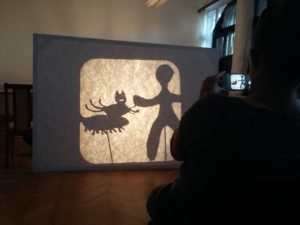
Story creation and performance
Group forming and puppet/story creation
Presentations
Reflection
- Questions helping the reflection after the activity:
- How you see your presence in the show?
- What does the stories tell you?
- How your animal was presented?
- Was your animal in the foreground or the background?
- How did it expressed itself?
- How did it connected to the other characters?
- What are these informations means to you personaly?
- Was there anything new, that you understand about yourself?
- Was there anything new, that you understand about others?
- Are you willing to use with your target group? Why-Why not? How would you like to use it? What would you like to change on it? Etc.





